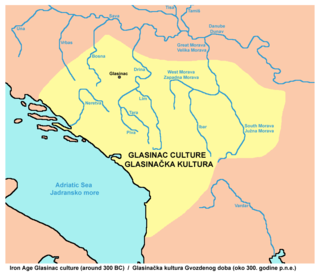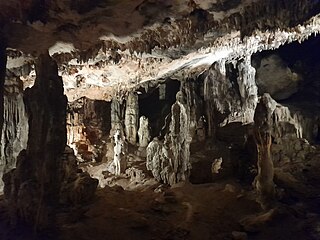Related Research Articles

The Bosna is the third longest river in Bosnia and Herzegovina, and is considered one of the country's three major internal rivers, along with the Neretva and the Vrbas. The other three major rivers of Bosnia and Herzegovina are the Una, to the northwest; the Sava, to the north, and the Drina, to the east. This river is the namesake of Bosnia. The river Bosna flows for 282 kilometers (175 mi).

Visoko is a city located in the Zenica-Doboj Canton of the Federation of Bosnia and Herzegovina, an entity of Bosnia and Herzegovina. As of 2013, the municipality had a population of 39,938 inhabitants with 11,205 living in Visoko town. Located between Zenica and Sarajevo, Visoko lies where the river Fojnica joins the Bosna.

The Histri or Istri were an ancient people inhabiting the Istrian Peninsula, to which they gave the name. Their territory stretched to the neighbouring Gulf of Trieste and bordered the Iapydes in the hinterland of Tarsatica. The Histri formed a kingdom.

The Autariatae or Autariatai were an Illyrian people that lived between the valleys of the Lim and the Tara, beyond the Accursed Mountains, and the valley of West Morava. Their territory was located inland from the Ardiaei and the Lake Skodra, extending east to the Dardani and north or northeast to the Triballi.

Daesitiates were an Illyrian tribe that lived on the territory of today's central Bosnia, during the time of the Roman Republic. Along with the Maezaei, the Daesitiates were part of the western group of Pannonians in Roman Dalmatia. They were prominent from the end of the 4th century BC up until the beginning of the 3rd century CE. Evidence of their daily activities can be found in literary sources, as well as in the rich material finds from Central Bosnian cultural group that is commonly associated with tribe of Daesitiates.

The Labeatae, Labeatai or Labeates were an Illyrian people that lived on the Adriatic coast of southern Illyria, between modern Albania and Montenegro, around Lake Scodra.

The Glasinac-Mati culture is an archaeological culture, which first developed during the Late Bronze Age and Early Iron Age in the western Balkan Peninsula in an area which encompassed much of modern Albania to the south, Kosovo to the east, Montenegro, southeastern Bosnia and Herzegovina and parts of western Serbia to the north. It is named after the Glasinac and Mati type site areas, located in Bosnia-Herzegovina and Albania respectively.

Grapčeva cave is a Neolithic and Bronze Age archaeological site. Three distinct prehistorical cultures were discovered here: Nakovan, Cetina and Hvar culture.

Central Bosnia is a central subregion of Bosnia, which consists of a core mountainous area with several basins, valleys and mountains. It is bordered by Bosnian Krajina to the northwest, Tropolje to the west, Herzegovina to the south, Sarajevo to the east and Tuzla to the northeast. It is a part of the Federation of Bosnia and Herzegovina and is divided between the Central Bosnia Canton and the Zenica-Doboj Canton, with a population of around 800,000. The largest city in the region is Zenica, with the Sarajevo-Zenica basin being the most densely populated area. Its highest peaks are Vranica, Šćit and Bitovnja.

The Cetina culture is the name for the culture of the inhabitants of the Middle Dalmatian coast, and especially its hinterland, during the early Bronze Age, or, according to Paul Reineck's chronology, Br A1 - A2/B1. It is named after the numerous sites along the Cetina river in Central Dalmatia and Herzegovina. People of this culture were present in caves or in open settlements. The graves are in rocky colonies. In the case of inhumation, they have the shape of a stone chest, while incinerated remains of the deceased are laid in clay pots.

The name of Bosnia is commonly used in English language as an exonym Bosnia, representing the South Slavic common endonym Bosna. The name was first recorded during the 10th century, in the Greek form Βόσονα, designating the region. In following centuries, the name was used as a designation for a Bosnian medieval state. After the Ottoman conquest in 1463, the name continued to be used as a designation for the Sanjak and Eyalet of Bosnia. After the Austro-Hungarian occupation in 1878, the region of Bosnia was reorganized and the name of its region of Herzegovina incorporated into the dual name of Bosnia and Herzegovina.

Dubravko Lovrenović was Bosnian and Herzegovinian medievalist, author and essayist, who worked at the Faculty of Philosophy of the University of Sarajevo, Department of History, in Sarajevo, Bosnia and Herzegovina.
Salmedin Mesihović is a Bosnian professor of history and archaeology at the Faculty of Philosophy, Department of History, at University of Sarajevo, Bosnia and Herzegovina.
Kakanj culture was an early Neolithic culture that appeared in Central Bosnia and covered periods dated from 6230–5990 to 5300–4900 BC.
Marko Šunjić, was Bosnian historian, medievalist, and the member of the Academy of Sciences and Arts of Bosnia and Herzegovina. He was born in Rodoč, near Mostar.

Branka Raunig was a Bosnian archaeologist, prehistorian and museum curator.

Glasinac is a karst plateau, situated in the eastern part of Bosnia and Herzegovina, on Romanija mountain, in the middle of Dinaric Alps. The main feature of the plateau is the Glasinačko Polje, a polje of 22 square kilometres, 7 km long, at an altitude of between 850 and 920 meters. The plateau consists of specious meadows and pastures, characteristic of the eastern part of Bosnia, whose lower levels consists of mostly hard impermeable rocks. The Glasinac plateau is surrounded by coniferous forests and peaks of Romanija, Bogovićka mountain, Gradina, Rab, Crni Vrh, Kopit and Kratelj. Sokolac town is located in the center of Glasinac, and has about 12,000 inhabitants.

Nada Miletić was a Bosnian medievalist, art historian and archaeologist, who was a scientific expert at the National Museum of Bosnia and Herzegovina and founded the study of the Migration Period in Bosnian archaeology.

Ključ Fortress is a medieval fortress in Bosnia and Herzegovina, above the modern-day town of Ključ. It is located on an elongated slope on high rocks that dominate the valley of the river Sana. Before it was redeveloped, there was a small ancient fortress from Roman times.
Blagoje Govedarica is a Yugoslav and Bosnian-Herzegovinian archaeologist. Born and educated in Serbia and Germany, he specialized in human prehistory.
References
- ↑ Čović 1983, p. 433-434, 450.
- ↑ Mesihovic, Salmedin. Rimski vuk i ilirska zmija. Posljednja borba (in Croatian). Salmedin Mesihovic. ISBN 978-9958-625-21-3.
- ↑ Fokkens, Harry; Harding, Anthony (2013-06-27). The Oxford Handbook of the European Bronze Age. OUP Oxford. ISBN 9780199572861.
- ↑ Bojanovski, Ivo (1988). "Ivo Bojanovski: Bosna i Hercegovina u antičko doba".
{{cite journal}}: Cite journal requires|journal=(help) - ↑ "Commission to preserve national monuments". old.kons.gov.ba. Retrieved 2019-11-09.
- ↑ Harding, Anthony; Fokkens, Harry (27 June 2013). The Oxford Handbook of the European Bronze Age. OUP Oxford. ISBN 9780191007330.
- ↑ "Borivoj Čović: OD BUTMIRA DO ILIRA". Kulturno naslijeđe, Sarajevo, 1976.
- ↑ "Borivoj Čović - Srednjobosanska kulturna grupa, str. 163-166; Ostave, str. 133-135; Kultura polja sa urnama,110-112". Arheološki leksikon -Zemaljski muzej, Sarajevo.
- ↑ "VELJKO PAŠKVALIN: Kamenjača, Breza kod Sarajeva − mlađeželjeznodobna i rimska nekropola" (PDF). Godišnjak centra za balkanološka ispitivanja ANUBIH, Knjiga XXXVII, strana 101.
- ↑ "Ana Marić -Nova interpretacija groba sa skeletnim ukopom žene iz mlađeg željeznog doba sa Kamenjače u Brezi kod Sarajeva" (PDF). Godišnjak centra za balkanološka ispitivanja ANUBIH, Knjiga XXXVII, strana 101.
- ↑ Mesihović, Salmedin. Salmedin Mesihović, ILIRIKE. Filozofski fakultet u Sarajevu. ISBN 9789958031106.
{{cite book}}:|work=ignored (help)